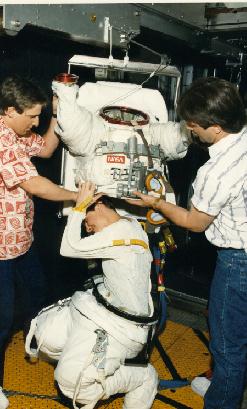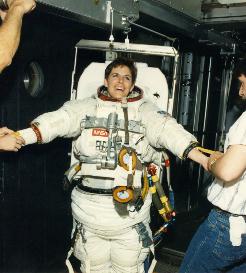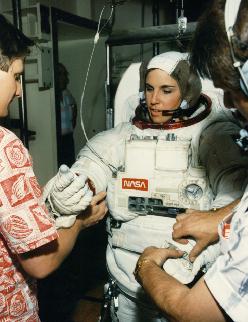Shuttle EMU Space Suit Donning Sequence
|
| This is the test subject. In this photo she is donning the LTA (Lower Torso Assembly) in preparation for a Shuttle EVA evaluation test in the Shuttle Airlock Vacuum Facility. She has already donned the LCVG (Liquid Cooling and Ventilation Garment). She is sitting on a pad provided to protect the LTA from the aluminum floor of the facility. The HUT (Hard Upper Torso) connected to the PLSS (Primary Life Support System) is in the upper right of the photo. The HUT and PLSS are bolted together and weigh about 90 kilograms (200 pounds) total. They are supported by a special weight relief system suspended from the top of the facility. All these assemblies together make up the EMU (Extra-vehicular Mobility Unit). This is not the facility in which she made the long endurance record. |
|---|---|

| As a final evaluation before astronauts were to perform dry runs in this facility set up to test tools for the Hubble Space Telescope launching mission, we asked a young female engineer from our office (not a qualified test subject) to try out the mobility and reach to the various test fixtures. In this photo she has donned the lower torso and is beginning the process of donning the upper torso. This is not a 'real' space suit. The upper and lower torsos are flight suits that were 'downgraded' for training purposes. The 'life support system' on the back is just a weighted shell with air ventilation tubes and water tubes built in. Air flow and pressurization is provided from a pressurized, certified breathing air supply. |

| Because the upper torso, with life support system attached, is so heavy it must be held up by a 'weight relief' system in 1-G, donning requires the subject to crawl up into the upper torso while trying to place hands and arms through the suit arms and keep the head in position to squeeze through the neck ring. |

| Subjects head is through the neckring and arms are through the sleeves. Suit technicians are adjusting the sleeves of the water cooled undergarment (LCVG). A simple, efficient lab cooler system provides cold water for the LCVG; a small electric pump pumps water from a ice chest to the suit. The communications headset is hanging down the front of the suit and the waist ring connection between the upper and lower torsos has not yet been made. |

| The test subject has now donned the headset and gloves. The waistring has been connected and the technicians are adjusting the gloves for best fit. |

|
With helmet installed, the donning is complete. The technicians adjust suit air flow and pressure with controls in the air line. The subject is preparing to step over the threshold of the open door into the chamber. This is a difficult step because the pressurized suit legs are hard to bend. People with longer legs have less difficultly bending the legs. However, in this facility, the weight relief system works better for short people so the difficulty of getting through the door is a tradeoff. The weight relief system runs on a track over head. When the door is opened between airlock and chamber, the track rolls into the door on a track of its own and locks to the track inside the chamber. |
| PAGE ONE - Brief summary of the records of the first women in space. Kathy Sullivan just barely misses an opportunity to be the first woman to do an EVA. More photos. | |
PAGE TWO - A time-in-suit record is set. Photos of female test subjects during sequence of suit donning steps.
| PAGE THREE - More photos of Kathy Sullivan during vacuum chamber dry-run activities for the Hubble Space Telescope Tools Test.
| |
